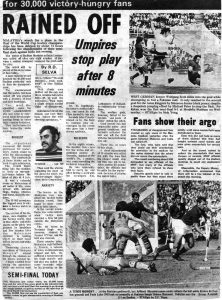
By
Franco De Cruz: There were parallels between the 1972 Munich Olympics and the 1975 World Cup teams. By that I mean, only the chosen 13 or 14 players in both teams played throughout the tournaments.
In the 1972 Munich squad, we had two goalkeepers, three fullbacks, four halfbacks, and nine forwards. We had an excess of forwards. Sadly, in spite of injuries to regular forwards, the reserves being four could not be called upon as replacements.
This was due to the structure and system of our play. I must say it was with disappointment that some of us had to struggle on, and continue playing in the competitions despite severe pain from injury.
In the Munich Games, we had achieved the best results in comparison to other Malaysian Olympics teams that had participated in past Games. But, if the selection process had been based on versatility of players, the results may have been better than they were.
At Munich, we were very close to qualifying for the semi-finals, and this was achieved in spite of playing with players carrying injuries. Can one imagine if we had the advantage of versatile replacements?

In the 1975 World Cup squad, we had two goalkeepers, three fullbacks, six halfbacks, and five forwards. During competition, the team was affected by injuries. We had three players off the field, and one being a forward, resulted in the coach having to improvise, and utilise one of the halfbacks as a replacement forward.
It was unfortunate that injuries did play a big part, mainly towards the later stages of the competition. The demands on the regular 13/14 players who were required to play constantly were physically too much. This was evident when we went to extra-time against India in the semi-finals and when we played in the third/fourth placing match against Germany.



 If you have an interesting personal story of a sports personality with photographs and video, we would like to publish it on this site.
If you have an interesting personal story of a sports personality with photographs and video, we would like to publish it on this site.


